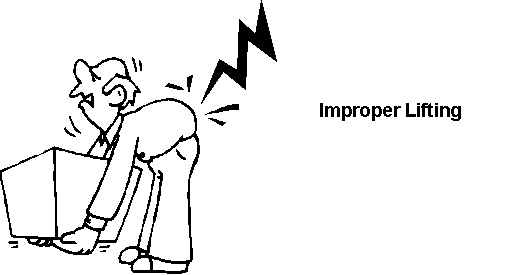Lifting (Download)
LIFTING 1 Lifting Lifting-related back injuries are among the most commonly reported workplace injuries. They are also costly and result in lost productivity.* *(lifting-2 document) pic : http://labsafety.tamu.edu/safelifting.asp 2 History There is no information about the first reported back injury during construction but it is assumed that back injuries have been around throughout history. Whenever heavy lifting was involved, there were sure to be work-related back injuries. This is especially true as there were less means of mechanical lifting aids in years past. 3 The use of lifting in construction The construction industry uses manual lifting frequently, depending on the trade. A worker who installs granite may do much more heavy lifting than a worker doing trim work. Lifting is often used to transport materials from where they are stored to where they are needed for installation. 4 The spine is made up of 24 small bones called vertebrae. These vertebrae are spaced by discs that absorb the pressure that movement places on the body. The vertebrae provide support for yhe body and protect the spinal cord. Safety Concerns: http:// www.safety.duke.edu/Ergonomics/Stretch/Lift_Spine.htm 5 The spine forms three curves (Cervical, Thoracic, and Lumbar) which help the back absorb forces and reduce the stress on the spine. The back muscles located along the spine are in their strongest position when the three curves are maintained. When work is performed without maintaining the natural curves of the spine, the back muscles cannot support the spine as well. This leads to uneven compression on the discs, increasing the risk of back injury. 6 Back injuries are considered by OSHA as the nation’s leading workplace safety problem. * According to the Bureau of Labor Statistics, more than one million workers suffer back injuries each year. ** * http://www.free-training.com/osha/back/Back/1.htm ** http://www.ehs.okstate.edu/training/oshaback.htm ***http://www.premierinc.com/safety/topics/back_injury/ Statistics On Lifting Related Injuries 7 Back injuries are cited as the most common reason for absenteeism in the general workforce after the common cold. About 80 percent of adults are estimated to experience a back injury in their lifetime, and about 10 percent will suffer a re-injury.*** 8 Back injuries account for 40% of all construction site injuries. * In the United States, back disorders account for over 24 percent of all occupational injuries and illnesses involving days away from work, according to the National Institute of Occupational Safety and Health’s (NIOSH)** One-fourth of all compensation indemnity claims involve back injuries. *** Back injuries cost the nation an estimated 20 to 50 billion dollars per year. **** * Utility Contractor, October 1998 ** http://www.premierinc.com/safety/topics/back_injury/ *** http://www.ehs.okstate.edu/training/oshaback.htm **** http://www.cdc.gov/Niosh/backbelt.html Statistics On Lifting-Related Injuries 9 Major Safety Concerns While Lifting About 80 percent of back injuries are short in duration, and workers are able get back to normal health. In the short-term, they may experience pain and reduced functioning. For some, the pain and suffering is long-term and even lifelong. For employees with long-term, disabling musculoskeletal injuries, lifetime earnings may drop significantly. These employees may also suffer a loss of independence and a diminished quality of life. * *http://www.premierinc.com/safety/topics/back_injury/ 10 Typical Hazards: http:// www.safety.duke.edu/Ergonomics/Stretch/Lift_Spine.htm Certain motions, actions, and movements are more likely to contribute to back injuries than others. These can include: – Heavy lifting, especially repetitive lifting over a long duration – Twisting at the waist line while lifting – Reaching and lifting Lifting or carrying objects with an awkward or odd shape Picking objects up with knees unbent which strains lower back 11 Causes of back injuries: Organizational causes: Many factors affect back injuries among construction personnel: an aging workforce, heavy lifting, staffing shortages, obesity in employees, gender, and stress due to organizational change. Individual causes: Back pain and other work-related musculoskeletal injuries may be caused by: A single traumatic event (a slip and fall), genetics; age (older populations experience an increase in arthritis and disc degeneration); being overweight; poor posture; bending, standing, sitting, or lifting improperly; tension, emotional problems or personal stress; pregnancy; tobacco smoking; poor physical condition; and sports. Cumulative trauma to the spine and related structures. http://www.premierinc.com/safety/topics/back_injury/ 12 Cumulative Trauma Disorders (CTDs) Most work-related musculoskeletal injuries occur from cumulative injuries, and are therefore called “cumulative trauma disorders” (CTDs). For example, overexerting the spine – from lifting improperly or lifting heavy objects. Because these small injuries do not cause pain, the employee is usually not aware the disk has been damaged. If not allowed to heal, the damage may build up and result in a bulging or ruptured disk, creating a cumulative injury marked by pain. http://www.premierinc.com/safety/topics/back_injury/ 13 Fatality Data OSHA djd not investigate any fatalities that related to back injuries from 1990 thru 2009. 14 OSHA Regulations There are currently no OSHA regulations on lifting. However, back injuries are still widely found in the workplace. OSHA encourages employers to implement Ergonomic Programs to reduce the number of back injuries in the workplace . * * http://www.osha.gov/SLTC/ergonomics/index.html 15 PPE for Lifting Use gloves to protect hands from sharp or rough edges and for an improved grip. Hard Hats are always to be worn n the job site. If lifting is for elongated time increments, a weight (back support) belt is suggested. 16 4 Step Prevention Plan document:lifting 2. 17 Step 1. Implement Engineering Controls Appropriate engineering controls can be highly effective in reducing lifting-related injuries. For example: Mechanical assist devices to relieve heavy load lifting and carrying tasks Handles or slotted hand holes in packages requiring manual handling Lighter-weight packaging materials Modified containers and parts presentation (e.g., height-adjustable material bins) Changes in workstation layout (e.g., use height-adjustable workbenches, position tools and materials within short reaching distances) 18 Fixtures (e.g., clamps, vise-grips) to hold work pieces to relieve the need for awkward hand and arm positions Suspended tools to reduce weight and allow easier access Easy-connect electrical terminals to reduce manual force Removal of physical and visual obstructions when assembling components to reduce awkward postures or static exertions 19 Step 2. Use Administrative Controls Administrative controls should also be part of the plan to reduce lifting-related back injuries. For example: Reduce shift length or curtail the amount of overtime. Rotate workers through several jobs with different physical demands to reduce the stress on limbs and body regions. Schedule more breaks to allow for rest and recovery. 20 Vary job content to offset certain risk factors (e.g., repetitive motions, static and awkward postures ). Adjust the work pace to relieve repetitive motion risks and give the worker more control of the work process . Train employees to recognize lifting risk factors and to follow work practices that ease the task demands or burden. 21 Step 3. Encourage the Use of Alternative Lifting Techniques Alternative material handling techniques for carrying or moving loads should be used whenever possible to minimize lifting and bending movements. Alternatives might include the use of equipment such as: Hand trucks Forklifts Pallet jacks and power pallet jacks Dollies Carts Hoists 22 Step 4. Teach Safe Lifting Techniques Train employees to: Stretch briefly before lifting to loosen up back, arm, and shoulder muscles. Determine whether more than one person or a mechanical device is needed for moving a load. Ask for assistance if needed. Break down the load into parts where feasible. Get a good grip on the load. Keep the load close. Keep balance with footwork. Lift with the back straight. Use the legs to lift without bending the back. Never twist or turn while lifting. Avoid lifting above the shoulder level. 23 OSHA’s Ergonomics: An alternate technique 24 Ergonomics Ergonomics is the study of the relationship between people, their work and their physical work environment The major goal of ergonomics is to fit the job to the individual and promote healthy and safe work practices 25 Ergonomics Identify hazards on the Jobsite. Review and analyze Injury Records. – Determine whether there is a pattern of ergonomic related injuries in certain jobs or work tasks 26 Ergonomics Analyze the Tasks to be Performed. Identify potential ergonomic problems before injuries occur. – Get employee input. 27 Ergonomics Training. Workers have been trained to identify all lifting hazards on the jobsite and how to avoid injury. Workers have been trained in safe lifting techniques. 28 1. Clear the Path – Make sure yhere is plenty of room to lift the object properly. – Check to make sure nothing blocks the path to the destination. – Prop doors open or have someone hold them open. – Avoid slippery or uneven surfaces. 5 Steps to Safe Lifting 29 2. Size up the Load Push the object lightly or lift a corner to get a sense of its weight. If the load is too heavy, break it down into smaller loads, get help or use a dolly or cart. Make sure the contents will not shift while being moved . 5 Steps to Safe Lifting 30 3. Make the Lift – Use proper lifting techniques. – Use appropriate PPE when lifting objects. 5 Steps to Safe Lifting 31 4. Carry the Load – Hold the load close to the body between the shoulders and waist. – Keep the back straight or slightly arched. – Change directions by using the feet. – Do not twist at the waist. 5 Steps to Safe Lifting 32 5. Set the Load Down – Use the legs to squat down and lower the object. – Rest the back and stretch after the lift. 5 Steps to Safe Lifting 33 Mechanical Lifting Alternatives Hand-Trucks, Pushcarts & Forklifts relieve the strain of heavy and repetitive lifting by moving larger loads safely and easily. It is important to remember proper lifting techniques when loading and unloading equipment. 34 Ergonomics Design Layout. Jobs are designated to minimize manual material handling. Mechanical lifting devices are available and in good working condition. Lifting tasks are divided among workers to reduce repetitive lifting. – Heavy materials are stored off the floor, no lower than knee height . 35 Training Tips and Techniques 36 Tip 1 Training is to impart knowledge that others do possess. Always speak calmly and in ways that show genuine care for the worker’s well being and not demanding orders. Pic : http://healthandfitness101.com/?p=91 37 Tip 2 Display visual aids that are easy to understand, regardless of language. http://livewellworkwell.wordpress.com/wellness-library/lifting-ergonomics/ 38 Tip 3 Make lifting aids such as dollies, carts and pallet jacks readily available or upon request. http://hubpages.com/hub/Hand-Dolly-Reviews 39 Perform Train employees proper lifting techniques when oriented. Give praise for correct lifting techniques and correct bad techniques. And remember, influence them to do the right thing on their own. http://www.sunyopt.edu/EHS/info.shtml 40 Think safety Work Safely 41

